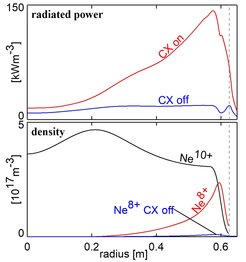Drastic Increase of Radiated Power due to Neutral Hydrogen
In ASDEX Upgrade, a strong influence of neutral hydrogen onto the mean charge and radiation of neon and argon was found
In a fusion reactor, a large part of the produced power has to be exhausted by radiation at the edge of the confined plasma to prevent a power overload of the divertor. Even a very low concentration of neutral hydrogen can drastically increase the power radiated by impurities.

For a plasma in ASDEX Upgrade, density profiles of Ne10+ und Ne8+ have been measured and modelled. The measured Ne8+ profile is much higher than the model when the charge exchange with neutral hydrogen is neglected. This effect of CX on the ionisation balance also causes a strong increase of the radiated power per volume.
This happens via charge exchange (CX) between the neutral hydrogen and the highly charged ions of the impurity, a process by which the electron of hydrogen is transferred to the ion. For neon, this leads to a strong increase of the ions with two bound electrons (helium-like Ne8+). Together with the neighbouring ion stages, they can emit much more power in the resonance lines than the fully ionised Ne10+, which can only contribute via bremsstrahlung. At ASDEX Upgrade, this effect could be shown by measurements of the density profiles of Ne10+, Ne8+, and the corresponding radiation profiles. Without CX, the calculated density profiles of Ne8+ are below the measurement by up to a factor of 28 and the calculated radiated power per volume is too low by up to a factor of 12. For argon, the same mechanism could be verified via the measured line radiation of many ion stages. However, the effect on the radiation is about a factor of 2.5 weaker than for neon. For the elements that are foreseen for radiation cooling in a reactor, first projections show that there is a beneficial increase of radiated power at the edge per radiated power in the core for the lighter elements up to krypton while the effect becomes weak for xenon and tungsten.
This investigation has recently been published in Nuclear Fusion.
